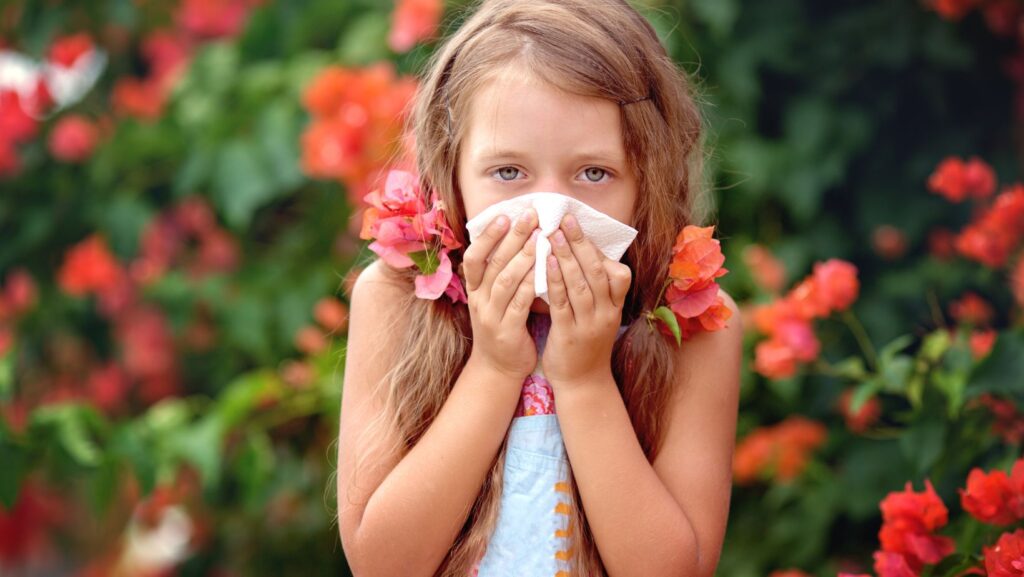Allergies affect millions of children. Over a quarter of American children have at least one allergic condition, such as seasonal allergies, eczema, or food allergies. If your kiddo has an allergy, you’re probably all too familiar with the uncomfortable and irritating symptoms they can cause. Runny noses, itchy eyes, scratchy throats, and overall discomfort often accompany an allergy.
While plenty of readily available commercial treatments can help address allergy symptoms, you might prefer a natural route. If that’s the case, you have a couple of natural allergy medicine options. Some are more effective and longer-lasting than others, but each can be worth considering.
Allergies in Children: Explained
A child’s allergies are just like an adult’s—they’re the immune system’s reaction to a foreign substance. They occur when your child’s body flags that substance, called an allergen, as harmful. Their body produces antibodies, blood proteins that counteract a specific antigen, which jump into action when exposed to the allergen.
Those antibodies communicate with specific cells, triggering a chemical release that causes the symptoms you recognize as an allergic reaction. Symptoms of an allergic reaction in children can include:
- Skin rashes
- Hives
- Sneezing
- Coughing
- Difficulty breathing
- Stomach upset
- Runny nose
- Itchy eyes
Natural Allergy Remedies for Kiddos
If you’re looking for a natural allergy remedy to help your kiddo find relief from irritating symptoms, you have a couple of options, including:
Saline Nasal Sprays
Saline nasal sprays are one of the simplest and safest ways to combat nasal congestion in your kiddo. These sprays use a simple saltwater solution to flush allergens from your child’s nasal passages. They can clear mucus from your child’s nose, helping improve breathing without using medication.

Usage instructions can vary from one product to the next, so be sure to check the label for instructions on how to use the product.
Quercetin
Quercetin is a natural compound found in various fruits and veggies, such as apples, onions, and berries. It acts as an antioxidant and boasts anti-inflammatory and antihistamine properties, so it can be a great tool in alleviating allergy symptoms.
You can easily incorporate this option into your child’s diet by adding quercetin-rich foods to the mix, like apples, berries, spinach, and broccoli. You can also give quercetin supplement capsules or powders, but if you want to go this route, ensure you chat with your child’s doctor before giving any supplements.
Probiotics
Probiotics, or beneficial bacteria, can help balance the immune system and may reduce the likelihood of allergic reactions. Research has shown that maintaining healthy gut flora is essential in preventing and managing allergies, especially in children.
So, incorporate probiotic-rich foods into your child’s diet. Yogurt, kefir, sauerkraut, and miso are good options, although some have strong flavor profiles and might not be appealing to kiddos. You can also give probiotic supplements designed for children, but like quercetin supplements, it’s important to chat with your child’s doctor first.
Butterbur
Butterbur is an herbal remedy that can act as a natural antihistamine to reduce allergy symptoms. It can help relieve symptoms like sneezing, runny nose, and itchy eyes, which are all common symptoms of an allergy.
You can use butterbur supplements, but again, it’s important to chat with your child’s doctor first. If your pediatrician gives you the green light, be sure to choose a butterbur preparation free from pyrrolizidine alkaloids (PA-free), as these can harm the liver.
Essential Oils
Essential oils, such as eucalyptus, peppermint, and lavender, can provide allergy relief by reducing inflammation and opening nasal passages. They can be diluted for topical use or added to an aromatherapy treatment to enjoy the effects.
If you use the oils topically, always dilute them in a carrier oil, such as coconut oil or jojoba oil. Or, if you go the aromatherapy route, add a few drops of essential oils to water in a diffuser to disperse the scent throughout your child’s room.

Before using essential oils, especially topically, talk to your pediatrician. Use can present side effects, especially if ingested or not properly diluted, so it’s important to use them carefully.
Allergy Immunotherapy
Allergy immunotherapy (AIT) is a powerful solution designed to alleviate allergic symptoms through repeated exposure. It delivers a small, incrementally increasing dose of the allergen to your child’s body via tablets, drops, or an injection.
By repeatedly exposing your child’s immune system to the allergen, AIT gives the body ample opportunity to build an allergen-specific tolerance. Over time and with consistency, AIT can reduce the production of “blocking” antibodies, which are responsible for producing the allergic reaction.
It’s not a quick fix by any means. Your child’s immune system will need time to adjust and build a tolerance. This usually takes a couple of years, with the best results appearing in years two and three. However, you might notice the first improvements appearing within the first year.
Wrapping Up
Allergies in kiddos can be tough to manage, especially if you don’t like using commercially available treatments like decongestants or antihistamines. Thankfully, natural remedies like saline sprays, probiotics, and allergy immunotherapy can help. Of course, as with any change in your child’s medical care, it’s important to chat with your child’s doctor first. They can help you select the best fit for your child’s needs based on their medical history.
